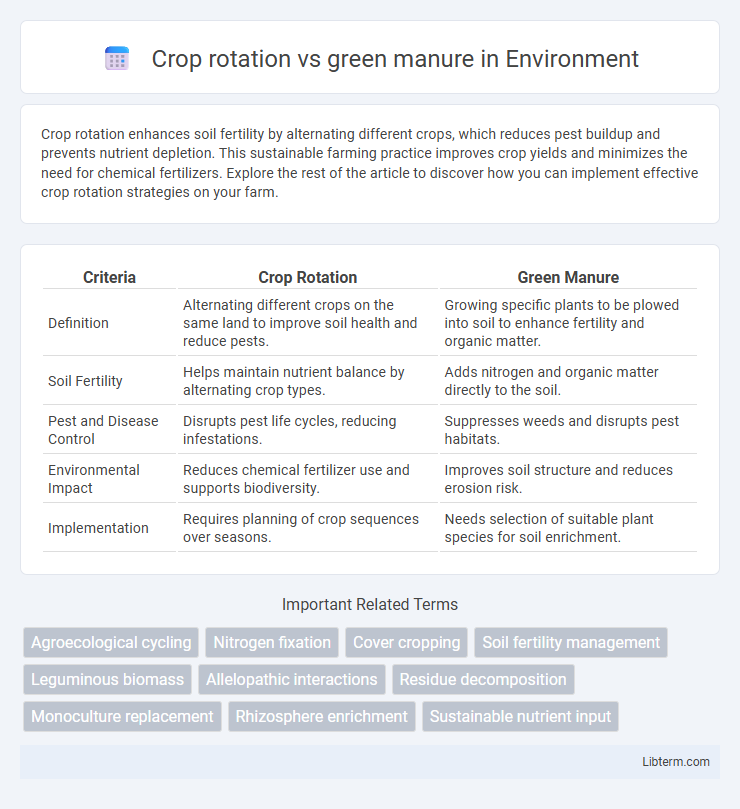Crop rotation enhances soil fertility by alternating different crops, which reduces pest buildup and prevents nutrient depletion. This sustainable farming practice improves crop yields and minimizes the need for chemical fertilizers. Explore the rest of the article to discover how you can implement effective crop rotation strategies on your farm.
Table of Comparison
| Criteria | Crop Rotation | Green Manure |
|---|---|---|
| Definition | Alternating different crops on the same land to improve soil health and reduce pests. | Growing specific plants to be plowed into soil to enhance fertility and organic matter. |
| Soil Fertility | Helps maintain nutrient balance by alternating crop types. | Adds nitrogen and organic matter directly to the soil. |
| Pest and Disease Control | Disrupts pest life cycles, reducing infestations. | Suppresses weeds and disrupts pest habitats. |
| Environmental Impact | Reduces chemical fertilizer use and supports biodiversity. | Improves soil structure and reduces erosion risk. |
| Implementation | Requires planning of crop sequences over seasons. | Needs selection of suitable plant species for soil enrichment. |
Understanding Crop Rotation: Principles and Benefits
Crop rotation involves systematically alternating the types of crops planted on a specific piece of land to improve soil health, reduce pest and disease buildup, and enhance nutrient cycling. This practice helps maintain soil fertility by preventing nutrient depletion, disrupting pest life cycles, and increasing organic matter. Compared to green manure, which adds organic nutrients through cover crops, crop rotation offers broader long-term soil sustainability and productivity benefits.
What is Green Manure? Definition and Types
Green manure refers to specific cover crops grown primarily to be incorporated into the soil, enhancing soil fertility and organic matter. Common types of green manure include legumes like clover and vetch, which fix atmospheric nitrogen, and non-leguminous plants such as rye and buckwheat that improve soil structure and suppress weeds. This practice promotes sustainable agriculture by reducing reliance on synthetic fertilizers and improving soil health over time.
Key Differences Between Crop Rotation and Green Manure
Crop rotation involves systematically alternating different crops on the same land to improve soil health, reduce pest and disease cycles, and enhance nutrient management, whereas green manure refers to specific plants grown primarily to be incorporated into the soil to increase organic matter and nitrogen content. Crop rotation targets long-term soil sustainability by diversifying plant species and reducing monoculture risks, while green manure focuses on immediate soil enrichment through biomass addition. Both practices are integral to sustainable agriculture but differ in purpose and execution--crop rotation emphasizes sequence planning of crops, and green manure centers on cover crops grown solely for soil amendment.
Soil Fertility: Crop Rotation vs Green Manure
Crop rotation enhances soil fertility by alternating nutrient-demanding crops with those that replenish nitrogen, reducing pest buildup and improving soil structure. Green manure involves incorporating cover crops like legumes into the soil to increase organic matter and nitrogen content, directly enriching soil nutrients. Combining both methods maximizes soil health, balancing nutrient supply and promoting sustainable agricultural productivity.
Pest and Disease Management Strategies
Crop rotation disrupts pest and disease cycles by alternating plant families, reducing the buildup of host-specific pathogens and pests in the soil. Green manure involves growing specific cover crops that release natural biofumigants or enhance soil microbial diversity, suppressing soil-borne diseases and pest populations. Combining crop rotation and green manure maximizes pest and disease suppression through diversified soil ecosystems and improved plant health.
Impact on Soil Structure and Erosion Control
Crop rotation enhances soil structure by alternating deep-rooted and shallow-rooted plants, promoting aeration and nutrient cycling, which reduces soil compaction and erosion risks. Green manure, typically composed of legumes or cover crops, improves soil organic matter and aggregate stability, significantly decreasing erosion by protecting the soil surface and increasing water infiltration. Combining both practices optimizes soil health, balancing nutrient replenishment with erosion control for sustainable agricultural productivity.
Nutrient Cycling and Organic Matter Enhancement
Crop rotation improves nutrient cycling by alternating deep-rooted and shallow-rooted plants, which optimizes nutrient uptake and reduces soil nutrient depletion. Green manure enhances soil organic matter by incorporating nitrogen-rich leguminous plants, boosting microbial activity and soil fertility. Both practices synergistically increase soil health by maintaining balanced nutrient levels and improving soil structure.
Sustainability: Long-term Effects on Farm Productivity
Crop rotation enhances soil structure and nutrient availability by alternating crops with different nutrient demands, reducing pest cycles and preventing soil depletion over time. Green manure involves growing specific plants to be incorporated into the soil, increasing organic matter and nitrogen content, which improves soil fertility and moisture retention. Both practices contribute to sustainability, but crop rotation offers more diverse long-term productivity benefits by maintaining balanced soil ecosystems and reducing the need for synthetic inputs.
Cost and Labor Considerations for Farmers
Crop rotation requires careful planning and timing to manage different crops effectively, which can increase labor demands but often reduces the need for expensive synthetic inputs. Green manure involves growing specific cover crops that must be planted and incorporated into the soil, adding labor costs related to sowing, mowing, and plowing, though it can improve soil fertility and reduce fertilizer expenses. Farmers must weigh the immediate labor and material costs of green manure against the longer-term benefits and labor shifts associated with diverse crop rotation schedules.
Choosing the Right Practice for Your Farming System
Choosing the right practice between crop rotation and green manure depends on your soil health goals and crop types. Crop rotation improves nutrient balance and controls pests by alternating plant families, while green manure enriches soil organic matter and nitrogen through cover crops. Evaluating soil conditions, climate, and crop demands ensures optimal integration of these sustainable practices.
Crop rotation Infographic

 libterm.com
libterm.com